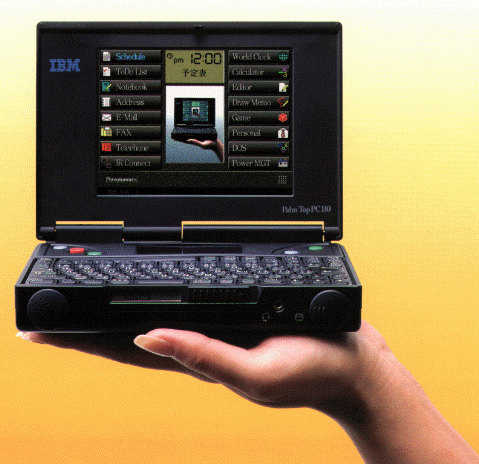DOS Palmtop: IBM Palm Top PC 110 Details and specs
IBM Palm Top PC 110

About this machine:
The IBM Palm Top PC 110 is truly unique and it stands out of the rest of the list from pretty much every aspect. Back in 1995 IBM was the most respected computer manufacturer in the western world, but in Japan they had a hard time as the Japanese always had smaller and more advanced laptops and considered the western models as "old fashioned" and "bulky". In 1995 the Japanese economy boosted so much it was pretty much "on par" with the world leader USA. So to finally claim this huge market IBM hired an army or engineers, spent a fortune and tried to develop the smallest and most advanced laptop ever. "World record or bust" was the concept. And oh boy - they succeeded. If you read my list then you already know that I normally only include computers that are small and use AA-Batteries unless there is a good reason. And for the IBM Palm Top PC 110 there are dozens of good reasons. At the time of it's release it was by far the smallest color screen notebook. It comes with a 256 color backlit VGA screen, 33 MHz 486SL processor, 4 MB base RAM (expandable to 20MB), 4MB SSD system drive, Compact Flash slot, 2 PCMCIA slots, ESS488 Sound card, internal speaker, touchpad, mouse stick, infrared port, modem and more. The machine can boot from the internal SSD, Compact Flash, PCMCIA or external FDD. It comes with a Japanese MS-DOS, but you can obviously install Windows 95, 98, 2000, OS/2, linux or others, limited only by the amount of RAM you have in the machine. And all that at such an incredibly small size that it is still impressive as of today. Hell you can even use it as a phone (no kidding). It even has a switch to turn off the ringtone if you prefer to not be disturbed. There were quite a lot of 3rd Party accessories, Hardware and stuff available for it back in the days, from the famous 20MB RAM Upgrades over faster Modems, custom colored cases, carrying bags to Speed hacks (You can Change the clock Speed from 33 to 40 MHz with some soldering).
Specs:
CPU: 80486sl @ 33MHz (low power without FPU)
Graphics: Chips & Technologies 65535 Accelerator, 512KB Video RAM
Display: 256 Color 4,7" DSTN LCD 640x480
Memory (RAM): 4 MB base RAM, extendable up to 20MB(Up to 28MB with custom made RAM module and soldering)
ROM (Software): 4 MB Flash based SSD
I/O ports: RS232 Serial, 2 x PCMCIA Type II slot (Or use as 1 x PCMCIA Type III), 2400/9600 fax modem, PS/2, IRDA 1.0, Earphone sockets, Port replicator socket
Sound: ESS488 Sound system (Sound Blaster Compatible)
Operating System: MS-DOS 7.0J (Japanese)
Software: Just some pretty basic Japanese PIM software.
Size: 158x116x36 mm
Powered by: Rechargable camcorder battery (Sony NP550 compatible) or AC adaptor (included)
Weight: 715 gram including battery and PCMCIA Type III HDD
Special features: Boots from all devices, color screen, sound card, modem, Infrared, touchpad, mouse stick, SSD, CF slot
Released: September 1995
Originally retailed for:: 169,000 Yen (Most basic model) to 289,000 Yen (8MB RAM with PCMCIA HDD)
Clone of: Not a clone
Similar models: Gateway 2000 handbook
Pros:
- Incredibly powerful and versatile
- Extremely small
- Everything you ever wished your palmtop would have
Cons:
- Battery life obviously shorter than some 8086 based palmtops
- Keyboard rather tiny
- Expensive and rather hard to get
- No AA batteries
Collector Value:
10 of 10
Usage Value:
10 of 10
Verdict:
Best palmtop in this list by far. It's considered a commercial failure as in 1995 The Yen was around 80 yen = 1 US Dollar, so around 3612 Dollars for the "better" model and that was only 8 MB RAM, not the 16 or 20 MB models that are considered "super collectibles" today. That would be around 5600 USD as of today (2014 US Dollars). With RAM expansion far over 6000 Dollars. They are cute but would you spend 6000 Dollar on a notebook? No? Actually many Japanese did back then, but at japan it was the time of the legendary "Bubble" when the real estate value of the imperial palace in Tokyo was roughly the value of the state of California (And their palace is not even THAT big). Back then people were throwing money around like there was no tomorrow. And then there was no tomorrow as the "Bubble" was over soon after. But luckily IBM produced quite a few of these. Even if they were only available in Japan you still have good chances to see maybe 2 or 3 every year on ebay. But beware as IBM laptop collectors usually kill each others for one of these, so probably not gonna be a bargain. However, no AA Batteries and a rather short battery life (4-6 hours in Windows 95 if you use power saving features). The good news is that it uses standard camcorder batteries, so for less than 10 bucks you can buy a new sony camcorder battery clone as of today (NP 550, NP 530 and so on). So small it even makes all netbooks of today look oversized. Even 20 years later there are very few computers that are smaller than this miracle. Finally a milestone of computing history you can hold in your hand. And I'd have it in one list with the Cray supercomputers and Konrad Zuse's first tube based computers. There are palmtops that are even more rare, but i still give it a collectors value of 10 out of 10 because it is probably the most important collectible for laptop, palmtop, computer and IBM enthusiasts at once.
Back to the Palmtop PC index
